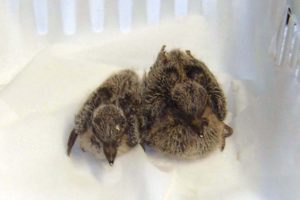Mourning Doves do not build their own nests. They often nest directly on the ground under a low bush. They will also nest in old bird nests, flower pots—just about anywhere. There are usually two babies to a nest. Unlike other songbirds, the parents do not feed them often and may only visit them for feeding several times each day.
It is easy to determine if a nestling dove has been recently fed by the parents. In the picture below, the dove on the right has been recently fed and has a swollen neck area. The dove on the left has an empty crop. A baby dove can be checked periodically to see if the crop area enlarges. If it does, the parents are feeding it.
If a baby dove is not injured, then leave it alone. It is fine, and the parents are caring for it.
Young fledgling and pre-fledgling doves look much like the adults. You can easily tell the difference by the shape of the tail. Adults have a sharply pointed tail, whereas a juvenile’s tail is rounded.
Young doves are easily approached and should be left alone except when they have an obvious injury.
GET THE BOOK
Your POCKET REFERENCE GUIDE to injured or orphaned wild animals!
Print book available on Amazon – $9.95
Available on Kindle – $2.99
Free on Kindle Unlimited
When rescuin g injured wildlife, the choices you make will impact that animal’s life and possibly your own. Knowing about the risks to the animal as well as to you, your family and your pets, along with the right advice from the beginning can mean the difference between a heartwarming, educational experience and disaster.
g injured wildlife, the choices you make will impact that animal’s life and possibly your own. Knowing about the risks to the animal as well as to you, your family and your pets, along with the right advice from the beginning can mean the difference between a heartwarming, educational experience and disaster.
This informative guide teaches would-be rescuers how to identify an animal in need, capture that animal, and safely transport it to a wildlife rehabilitator.
• How to determine the status of an injured creature using easy-to-follow flow charts
• Instructions on safe-capture methods, emergency care, transportation, and finding a professional wildlife rehabilitator
